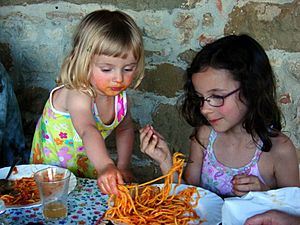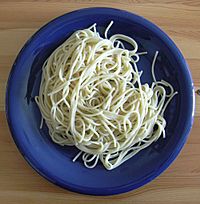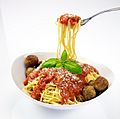Spaghetti facts for kids
|
Kids eating spaghetti
|
|
| Type | Pasta |
|---|---|
| Place of origin | Italy |
| Main ingredients | Semolina or flour, water |
Spaghetti is a long, string-shaped kind of pasta.
The word spaghetti was first used in 1849 as sparghetti in Eliza Acton's Modern Cookery. It comes from Italian spaghetto, which means "string".
Spaghetti is made from wheat noodles, which are boiled in water for a short time. Spaghetti can either be served as a side dish, or as a main dish. As a main dish, a sauce is added. There are many different kinds of sauces. Simpler ones are made of butter, more complicated ones include tomatos, garlic, olive oil and various other herbs. Different varieties with mussels, fish or meat also exist. Ground Parmesan cheese is often added.
In Italy the sauce is usually mixed with the spaghetti while they are being prepared. Usually, spaghetti are eaten only with a fork, or with a fork and a spoon. Sometimes, they are cut with a knife for small children. Many Italians see using a knife to eat spaghetti as bad manners, except to prepare them for small children.
There is a story about how spaghetti came to Italy. In the legend, Marco Polo found spaghetti in China during his visit in 1295, and he took some back to Italy.
Today, spaghetti is eaten everywhere. In the United States, there is a kind of spaghetti called "Alvaro's spaghetti" which is served with alfredo sauce. In some countries,like United States or Canada, meatballs are often in the spaghetti sauce.

Contents
History
The first written record of pasta comes from the Talmud in the 5th century AD and refers to dried pasta that could be cooked through boiling, which was conveniently portable. Some historians think that Arabs introduced pasta to Europe during a conquest of Sicily. In the West, it may have first been worked into long, thin forms in Sicily around the 12th century, as the Tabula Rogeriana of Muhammad al-Idrisi attested, reporting some traditions about the Sicilian kingdom.
The popularity of spaghetti spread throughout Italy after the establishment of spaghetti factories in the 19th century, enabling the mass production of spaghetti for the Italian market.
In the United States around the end of the 19th century, spaghetti was offered in restaurants as Spaghetti Italienne (which likely consisted of noodles cooked pasta al dente (lit. to the tooth), and a mild tomato sauce flavored with easily found spices and vegetables such as cloves, bay leaves, and garlic) and it was not until decades later that it came to be commonly prepared with oregano or basil.
About spaghetti
In China, spaghetti is often made by hand. In Italy, spaghetti is made with a machine so that large amounts can be made quickly. Italy is the biggest producer and consumer of spaghetti in the world.
Spaghetti is called by other words when it has a different thickness: "spaghettini (n. 3)", "spaghetti (n. 5)", and "spaghettoni (n. 8)".
Images for kids
-
Classic spaghetti alla carbonara
-
Spaghetti bolognese, very common outside of Italy, but not customary in that country
-
Spaghetti cacio e pepe (cheese and pepper) at a restaurant in Rome
See also
 In Spanish: Espagueti para niños
In Spanish: Espagueti para niños





















